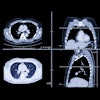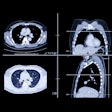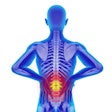
Wednesday, November 29 | 11:10 a.m.-11:20 a.m. | RC513-12 | Room E352
In this Wednesday morning presentation, researchers from Portugal will discuss their project to optimize radiation dose for the most common pediatric plain radiography exams performed in their country. They also aimed to develop diagnostic reference levels to set optimal dose levels that can be used across the nation.When pediatric patients get x-rays, the radiation dose they receive is generally pretty low. But that doesn't mean that more can't be done to optimize dose, especially as these patients sometimes undergo multiple radiography studies.
Data from Europe have shown wide variation in some of the most common diagnostic reference levels (DRLs), presenter Graciano Paulo, PhD, told AuntMinnie.com. The cause for this can vary, but reasons often include differences in socioeconomic conditions, regulatory practice, and the level of activity of professional bodies, as well as the structure of healthcare systems in terms of their private/public mix. Global bodies such as the International Atomic Energy Agency (IAEA) and the International Commission on Radiological Protection (ICRP) have recommended that countries perform their own national DRL surveys.
Such a survey has yet to be performed in Portugal, and, as a result, no national DRL levels have been set, Paulo noted. In fact, the need for radiation optimization and protection in Portugal has only become an issue in the past five years, he said.
To set DRLs for pediatric radiography, Paulo's group first used phantoms to develop optimal exposure factors for use at three Portuguese hospitals. Next, they developed DRLs for specific pediatric age and weight groups, based on the 75% percentile of the European guidelines for entrance surface dose kerma (ESAKP75) and kerma area product (KAPP75) obtained from x-ray studies of 10,000 patients. They then applied the new optimized exposure factors and calculated the dose reduction for both ESAKP75 and KAPP75 values.
The DRLs produced significant dose reductions across age groups, such as a reduction of 35% to 87% at the KAPP75 level and 17% to 87% at the ESAKP75 level for abdominal plain radiography. Dose reductions were similarly large when calculated by weight group -- for example, an 18% to 84% reduction at the KAPP75 level and 20% to 88% at the ESAKP75 level for abdominal plain radiography.
Tthe dose optimization involved relatively simple adjustments to the radiography equipment that were added to guidelines, including the use of automatic exposure control, ionization chambers, and antiscatter grids, as well as the use of additional filtration, Paulo noted. The moves have led to improved awareness among health professionals at the institutions.
"This work allowed proposing new and harmonized exposure parameters for chest, abdomen, and pelvis plain radiography, facilitating dose reduction by up to 94% with image quality being maintained," Paulo told AuntMinnie.com.
This paper received a Roadie 2017 award for the most popular abstract by page views in this Road to RSNA section.



















